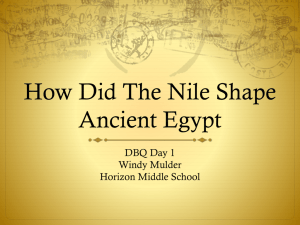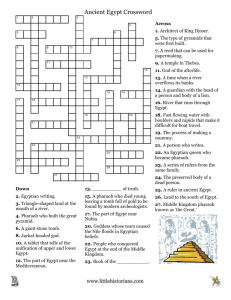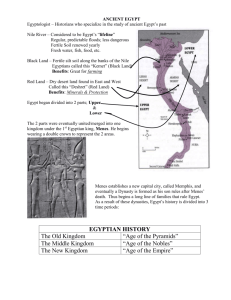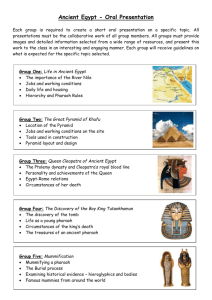Ancient Egypt . Crystal Wang Period.3 9/6/12 • The Predynastic and
advertisement
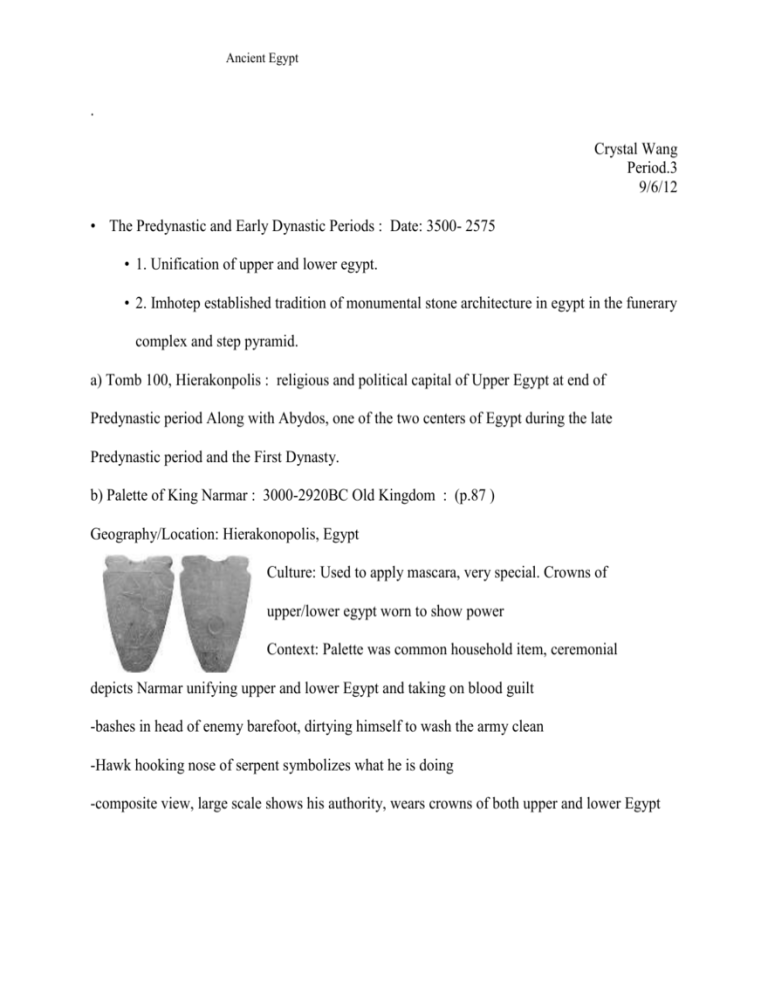
Ancient Egypt . Crystal Wang Period.3 9/6/12 • The Predynastic and Early Dynastic Periods : Date: 3500- 2575 • 1. Unification of upper and lower egypt. • 2. Imhotep established tradition of monumental stone architecture in egypt in the funerary complex and step pyramid. a) Tomb 100, Hierakonpolis : religious and political capital of Upper Egypt at end of Predynastic period Along with Abydos, one of the two centers of Egypt during the late Predynastic period and the First Dynasty. b) Palette of King Narmar : 3000-2920BC Old Kingdom : (p.87 ) Geography/Location: Hierakonopolis, Egypt Culture: Used to apply mascara, very special. Crowns of upper/lower egypt worn to show power Context: Palette was common household item, ceremonial depicts Narmar unifying upper and lower Egypt and taking on blood guilt -bashes in head of enemy barefoot, dirtying himself to wash the army clean -Hawk hooking nose of serpent symbolizes what he is doing -composite view, large scale shows his authority, wears crowns of both upper and lower Egypt c) Architecure : exceptional because it is commemorative rather than funerary in nature. ex: Predynamic mural from Hierakonpolis. Egyptian tomb= Egypt civilization. The majority monuments the Egyptians left behind is safety and happiness in the next life. d) Imhotep and Djoser : (p.87) e) Saqqara(north in lower Egypt) south of Giza Old Kingdom 2630-2611BC 1st pyramid of Egypt (stepped pyramid) Built by Djoser’s architect Imhotep 1st known recorded name of the architect recorded in history One of the oldest stone structures in Egypt and the first royal tomb Began as a large mastaba (series of stacked mastaba) Shaft and burial chamber underground ___________________________________________________________________________ ( The Old Kingdown) : The Old Kingdom is the name commonly given to that period in the 3rd millennium BCE when Egypt attained its first continuous peak of civilization in complexity and achievement – this was the first of three so-called "Kingdom" periods, which mark the highest points of civilization in the lower Nile Valley (the others being Middle Kingdom and the New Kingdom ). Ancient Egypt a) Architecture : “ the Great Pyramids of Gizeh, the oldest of 7 wonders of the ancient World. b) Great Pyramids, Gizeh : Period & Date: Old Kingdom 2500 BCE -Giant monuments to dead Pharaohs - Each pyramid as an enjoining mortuary temple - Huge pile of limestone with minimal interior for the deceased : pharaoh buried within the pyramid, unlike at the Stepped Pyramid, in which the pharaoh is buried under the building - Each side of the pyramid oriented toward a point on the compass - Great pyramids are faced with stone : these are without their outer layer c) Great Sphinx : Giza, Egypt. Limestone, 66' H. c. 2500 B.C.E.. - very generalized features, although some say it may be a portrait of Khafre, whose Pyramid sands behind the Sphinx. - Carved in situ from a huge rock, symbol of the Sun God. - body of a lion, head of a pharaoh = God. - Sphinx seems to protect the pyramids behind it. - Originally brightly painted to stand out in the desert. - Cats are royal animals in ancient Egypt, probably because they saved the grain supply from mice. - Head of the Sphinx badly mauled in the Middle Age. - Beard of Sphinx in the British Museum. d)Sculpture : Many exist because fulfill an important function in Egyptian as substitute abodes for the Ka. ** Primary material for funerary = Stone. e)Khafre Enthroned : 2520 b.c. : Ka Statute -egyptian (old kingdom) : Idealized features and body -Falcon god Horus is behind Khafre’s head, protecting him: Khafre is an incarnation of Horus : pharaoh divinely appointed -Symbol of a united Egypt in the interlocking of lotus and papyrus plants at the base. -Frontal, Symmetrical, rigid, motionless, cubic Figure not cut away from the stone : legs attached, no negative space b/t arms and stomach - Strict adherence to Egyptian canon of proportions. f) Menkaure and Khamerernebty : 2490-2472 BCE/ slate - Figure attached to block of stone. Arms and Legs not cut free -Figure stare out into space -Wife’s simple and affectionate gesture, presenting him to the gods -Mnkaure’s powerful physique and stride symbolize his kingship -Society’s view of women expressed in the ankle length and tightly draped gown revealing her form covering her body : Men and women the same height, indicating equality. a) seated Scribe : (ca. 2,400 BCE)/ limestone Ancient Egypt - Created for a tomb at Saqqara as a provision for the ka - Not a pharaoh: sagging chest and realistic rather than idealistic features - Color b) J)Tomb of Ti, Saqqara : Location: Saqqara, Egypt Culture: Egyptian Date: ca. 2510 BCE High person in administration of pharaoh Depicts- servants hunting hippos hierarchy of scale + canon of proportions + coloration and fluid bodies of servants= Ti is most important __________________________________________________________________________ ** The Middle Kingdom : from 2055-1650 B.C. : - restored order and reunited Upper and Lower Egypt -spent wealth on public works like building and irrigation projects -didn't spend wealth on wars -Egypt got richer -fall: weak rulers = foreign invaders a) Sculpture : Most in Old kingdom. b) Senusret III : 1860 BCE : Stone - Moody look in the eye and mouth : Depressed, rather than heroic figures seen in the Old Kingdom. - Figure reflect period of civil unrest - Introspective - Firm Chin - Carefully delineated line and folds of flesh b/t the brows and at the corners of nose and mouth. c) Architecture : d) Ben Hasan : Rock cut Tomb : 1950-1900 BCE : Egypt - Cliff walls hollowed out to reveal small burial chambers - Reserve columns cut away from the interior chamber to create the look of conventional columns - Columns are not round but fluted - Facade shows shallow columned porch. ________________________________________________________________ ** The New Kingdom -Architecture : Like pyramid, most egyptian temple have an astronomical orientation (The temple of Ramses II admits light into its deepest recesses at dawn Ancient Egypt on Ramas’ birthday) Column used in New Kingdom temple was based on plant shape : Lotus/Palm/ and Papyrus. - [Temple of Hatshepsut] : 1473-1458 BCE Deir dl- Bahri, Egypt . 3 colonnaded terraces and 2 ramps . visually coordinated with the natural setting : long horizontals and veritcals of the terraces and colonnades repeat the patterns of the cliffs behind : Patterns of dark and light in the colonnade are reflected in the cliffs . Terraces were originally planted as gardens with exotic trees . First time the achievements of a woman are celebrated in art history : her body is interred elsewhere. -[Hatshepsut’s Portraits] : 1473-1458 BCE / Garnite .Queen represent in male costume of a pharaoh, yet slender proportions and slight breasts indicate femininity . Often portrayed as a sphinx. . Headdress, false beard, and trace of the cobra on the crown show her affinity with male pharaoh role. . Some 200 sculptures exist, many smashed by her successor Thutmose III. -[Temple of Ramses II] : 1290-1224 BCE/ Abu Simbel/ Egypt . Rock-cut tomb resembles a pylon . Huge seated quarter of statues of Ramses on the facade, carved in situ . Sun god placed over the entrance . Facade at one time was brightly painted . Royal family located b/t Ramses’ legs . Sun enter the center door of teh tomb on Ramsei’s birthday, October 21, lighting up his statue deep in the interior. . Interior sculptures of Ramses are carved in reserve . Interior stretches 200 feet into the mountain -[Family of Ramses] : -[Temple of Amen-Re, Karnak] : 1290-1224 BCE, Karnak, Egypt . Huge columns, tightly packed together, admitting little light into the sanctuary . Hypostyle halls . Columns elaboratedly painted . Massive lintels bind the columns together . Axial plan -[Sculpture and Painting] : -[Senmut and Nefrura] : -[Tomb of Nebamun] : ______________________________________________________________ ** Akhenaton adn the Amarna Period -Nefertiti and Tiye : 1353-1335 BCE sandstone . Long, elegant neck . Realistic face ; soft, delicate New Kingdom features . Perhaps the sculpture wa demonstation model for copying .Wife of Akhenaton . Amarna style - Family Portraiture ____________________________________________________________ ** The Tomb of Tutankhamen and the Post-Amarna Period -Tomb of Tutankhamen : 1323 BCE / Gold/ Enemel/ Semiprecious stone . Famouse tomb discovered by Howard Carter in 1922 Ancient Egypt . Mummified body of King Tutankhamen buried with 143 objects on his head, neck, abodmen, and limb; gold mask places over head. . Gold coffin 6’7” log containing the body of the pharaoh .Golden mask has smoothly idealized features of the boy-king -Scroll of Hu-Nefer _____________________________________________________________ ** First Millennium BCE -Kingdom of Kush -Taharqo _________________________________________________________________ ** After Alexander -Temple of Horus, Edfu

